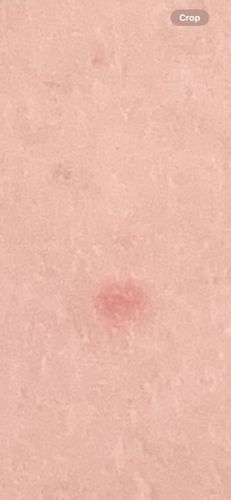Tick bite (likely common-name type such as Deer Tick, Lone Star Tick, etc., but cannot be definitively identified from an isolated bite mark)
Scientific Name: Ixodida (Order, specific genus/species not identifiable from bite alone)
Order & Family: Order: Ixodida, Family: Ixodidae (hard ticks) or Argasidae (soft ticks) - specific family not identifiable from image alone
Size: Tick size varies greatly by species and life stage, generally from 1-3 mm (unfed) up to 10-15 mm (engorged). The bite mark itself is about the size of the tick's mouthparts.

Natural Habitat
Grassy areas, wooded areas, brush, leaf litter. Varies by specific tick species.
Diet & Feeding
Blood (hematophagous) of mammals, birds, reptiles, and amphibians. They are typically obligate parasites, attaching to a host to feed.
Behavior Patterns
Questing behavior (climbing vegetation and waiting for a host), slow feeding (can attach for hours to days), typically solitary in their feeding on a host. Life cycle involves four stages: egg, larva, nymph, and adult, with blood meals required for progression.
Risks & Benefits
Potential risks include transmission of various pathogens causing diseases such as Lyme disease (Borrelia burgdorferi), Rocky Mountain spotted fever (Rickettsia rickettsii), ehrlichiosis, anaplasmosis, babesiosis, and Powassan virus. Can also cause allergic reactions or tick paralysis. No direct benefits to humans, but play a role in their ecosystems as parasites and food sources for some larger animals.
Identified on: 9/12/2025